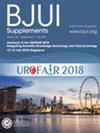Sexual function in adolescence after childhood hypospadias repair: a patient‐reported outcome study
IF 3.7
2区 医学
Q1 UROLOGY & NEPHROLOGY
引用次数: 0
Abstract
ObjectiveTo present data on sexual function in post‐pubertal patients after hypospadias surgery in childhood.Patients and MethodsWe assessed 169 (96 distal, 20 midshaft, 53 proximal) patients with hypospadias born between 1991 and 2003, who underwent surgery before the age of 5 years. At a median (interquartile range) follow‐up age of 16.2 (16.0–16.8) years, participants completed a pre‐mailed sexual function questionnaire, including the Erection Hardness Score (EHS) during the last control visit. Dorsal Nesbit‐like plication was used for curvature correction in 62 patients. Previously published normative data served as controls.ResultsAll patients reported having erections; 73% achieved EHS 4 (completely hard and fully rigid). In patients with distal hypospadias, EHS 4 was reported in 68% of cases, 85% of midshaft and 79% of proximal cases. Among those with and without curvature correction by Nesbit‐like plication, EHS 4 was reported in 72% and 74%, respectively. The proportion reporting EHS 4 exceeded that of published controls (儿童期尿道下裂修复后青少年性功能的影响:一项患者报告的结果研究
目的探讨儿童期尿道下裂手术后青春期后患者的性功能状况。患者和方法我们评估了169例(96例远端,20例中轴,53例近端)1991年至2003年间出生的5岁前接受手术的尿道下裂患者。在中位(四分位数范围)随访年龄为16.2(16.0-16.8)岁时,参与者在最后一次对照访问期间完成了邮寄前的性功能问卷,包括勃起硬度评分(EHS)。62例患者采用背侧内斯比特样应用进行曲率矫正。先前公布的规范数据作为对照。结果所有患者均有勃起;73%达到EHS 4(全硬和全硬)。在远端尿道下裂患者中,68%的病例报告了EHS 4, 85%的中轴病例和79%的近端病例报告了EHS 4。在采用Nesbit - like应用曲率校正和未采用Nesbit - like应用曲率校正的患者中,EHS 4的发生率分别为72%和74%。报告EHS 4的比例超过公布的对照(P <;0.01)。总体而言,95%的患者勃起时阴茎平直,尿道下裂亚型或弯曲矫正状态之间无显著差异。只有一名患者报告射精时疼痛;没有人报告勃起时疼痛。95%的参与者报告了射精。结论:早期行尿道下裂修复术的青少年性功能恢复良好,包括勃起强直和射精功能的高发生率。尿道下裂的严重程度和曲率矫正的需要都不影响这些结果。这些发现支持儿童期尿道下裂手术患者的长期性健康。
本文章由计算机程序翻译,如有差异,请以英文原文为准。
求助全文
约1分钟内获得全文
求助全文
来源期刊

BJU International
医学-泌尿学与肾脏学
CiteScore
9.10
自引率
4.40%
发文量
262
审稿时长
1 months
期刊介绍:
BJUI is one of the most highly respected medical journals in the world, with a truly international range of published papers and appeal. Every issue gives invaluable practical information in the form of original articles, reviews, comments, surgical education articles, and translational science articles in the field of urology. BJUI employs topical sections, and is in full colour, making it easier to browse or search for something specific.
 求助内容:
求助内容: 应助结果提醒方式:
应助结果提醒方式:


